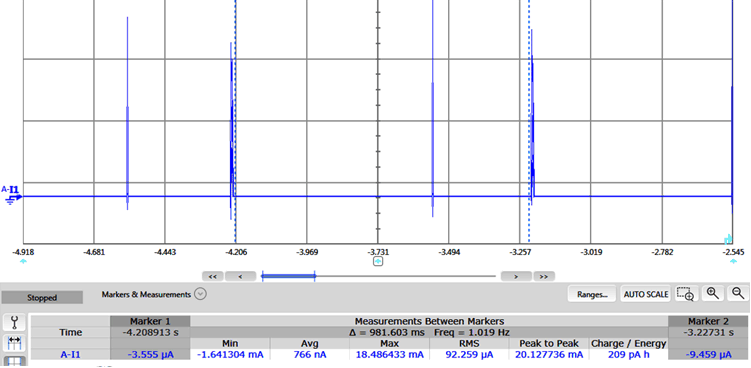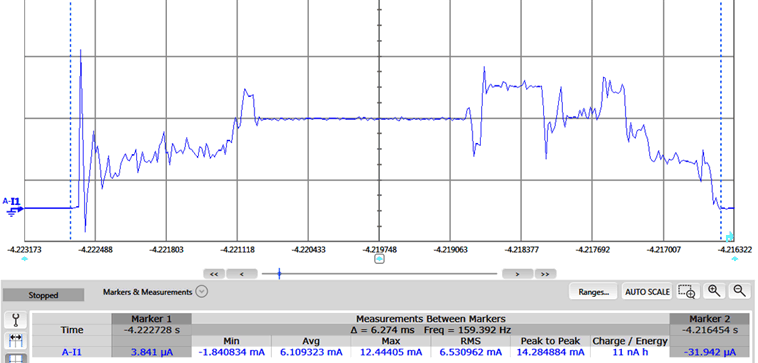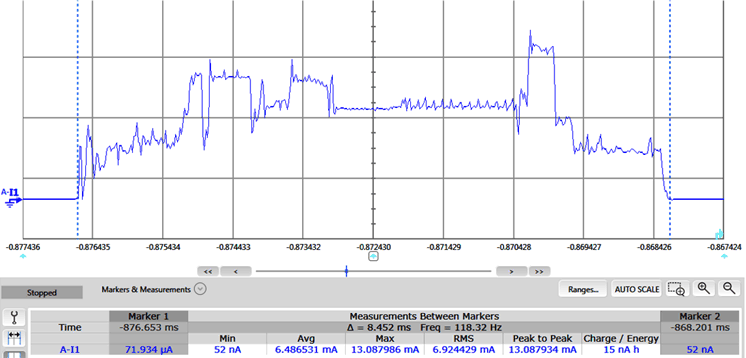SWRA625B August 2018 – February 2020 CC1352P , CC1352R , CC2652P , CC2652R , CC2652R7 , CC2652RSIP
- Z-Stack End Device Power Consumption Measurement With the SimpleLink Wireless MCU Family
- Revision History
5.1 Measurements for Regular ZED
In Operation1, the ZED is in standby mode. This mode can be carried out below the 1 µA threshold with full 80KB RAM retention. The SimpleLink CC1352P and CC2652R devices have excellent standby current performance across the full temperature scale. Figure 9 shows the average current consumption when the device is performing the standby operation, which was averaged at 0.8 μA.
 Figure 9. ZED Current Consumption Measurement in Sleep Mode
Figure 9. ZED Current Consumption Measurement in Sleep Mode In Operation2, the ZED is polling the ZC, sending a MAC Data Request command, and a MAC ACK from the ZC with the Frame Pending subfield set to 0 is received, indicating the ZC does not have any messages queued for the ZED. Therefore, the ZED goes to sleep right away, instead of staying in RX mode. MAC Data Request packets are 18 bytes long, including the 6 byte PHY overhead. In the same manner, the MAC ACK is 11 bytes long. The current consumption to perform one poll operation at 5 dBm was averaged at 6.1 mA and took 6.3 ms.
 Figure 10. ZED Current Consumption for One Polling Operation (5 dBm)
Figure 10. ZED Current Consumption for One Polling Operation (5 dBm) In Operation3, the ZED is a switch sending out an On/Off Toggle command, expecting an On/Off Toggle ACK from the ZC. This operation is a very typical use case for the light/switch example, which the switch sends a 48 byte ZCL Data packet to the ZC for toggling the light. After the Toggle command is sent, the ZED polls the ZC and a MAC ACK from the ZC with the Frame Pending bit set to 1 is received. RX mode is then kept open, listening for the ZC to send the Default Response for the Toggle command. The current consumption to perform one complete On/Off Toggle operation at 5 dBm was averaged at 6.5 mA and took 9 ms.
 Figure 11. ZED Current Consumption Measurement for One On/Off Toggle Operation (5 dBm)
Figure 11. ZED Current Consumption Measurement for One On/Off Toggle Operation (5 dBm) Table 2 lists the average current consumption of typical procedures in Zigbee at different power levels. The data was collected with devices operating from a 3.3 V power source, on a CC2652R for 0 and 5 dBm, and a CC1352P for 10 and 20 dBm. The two most frequent operations were performed, being a data poll operation and a ZCL command. There were 10 readings taken and all were averaged with the results shown in Table 2.
Table 2. Current Consumption of SimpleLink CC1352P/CC2652R for ZED Typical Use Cases
| Power Level | Complete Polling Operation | Complete On/Off Toggle Operation |
|---|---|---|
| 0 dBm | 5.82 mA | 6.4 mA |
| 5 dBm | 6.11 mA | 6.5 mA |
| 10 dBm | 7.91 mA | 10.05 mA |
| 20 dBm | 13.38 mA | 22.93 mA |